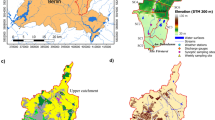Abstract
Water quality models of urban systems have previously focused on point source (sewerage system) inputs. Little attention has been given to diffuse inputs and research into diffuse pollution has been largely confined to agriculture sources. This paper reports on new research that is aimed at integrating diffuse inputs into an urban water quality model. An integrated model is introduced that is made up of four modules: hydrology, contaminant point sources, nutrient cycling and leaching. The hydrology module, T & T consists of a TOPMODEL (a TOPography-based hydrological MODEL), which simulates runoff from pervious areas and a two-tank model, which simulates runoff from impervious urban areas. Linked into the two-tank model, the contaminant point source module simulates the overflow from the sewerage system in heavy rain. The widely known SOILN (SOIL Nitrate model) is the basis of nitrogen cycle module. Finally, the leaching module consists of two functions: the production function and the transfer function. The production function is based on SLIM (Solute Leaching Intermediate Model) while the transfer function is based on the ‘flushing hypothesis’ which postulates a relationship between contaminant concentrations in the receiving water course and the extent to which the catchment is saturated. This paper outlines the modelling methodology and the model structures that have been developed. An application of this model in the White Cart catchment (Glasgow) is also included.
Similar content being viewed by others
References
Arnold, J.G., Srinivasan, R. and Ramanarayanan, T.S.: 1999, Water resources of the Texas gulf basin, Water Science Technology 39(3), 121-133.
Beven, K.J., Wood, E.F. and Sivapalan, M.: 1988, On hydrological heterogeneity-catchment morphology and catchment response, Journal of Hydrology 100, 353-375.
Birkinshaw, S.J. and Ewen, J.: 2000, Modelling nitrate transport in the Slapton Wood catchment using SHETRAN, Journal of Hydrology 230, 18-33.
Heathwaite, A.L., Johnes, P. and Peters, N.E.: 1996, Trends in nutrients, Hydrological Processes 10, 263-293.
Hornberger, G.M., Bencala, K.E. and McKnight, D.M.: 1994, Hydrological controls on dissolved organic carbon during snowmelt in the Snake River near Montezuma, Colorado, Biogeochemistry 25, 147-165.
Hornberger, G.M. and Beven, K.J.: 1985, Shenandoah Watershed Study: calibration of a topographybased, variable contributing area hydrological model to a small forested catchment, Water Resources Research 21(12), 1841-1850.
Hutson, J.L.: 1993, Applying one-dimensional deterministic chemical fate models on a regional scale, Geoderma 60, 201-212.
Iorgulescu, I. and Jordan, J.P.: 1994, Validation of TOPMODEL on a small Swiss catchment, Journal of Hydrology 159, 255-273.
Johnsson, H. and Bergstron, L.: 1986, Simulated nitrogen dynamics and losses in a layered agricultural soil, Agriculture, Ecosystems and Environment 18, 333-356.
Lenzi, M.A. and Di Luzio, M.: 1997, Surface runoff, soil erosion and water quality modelling in the Alpone watershed using AGNPS integrated with a GIS, European Journal of Agronomy 6, 1-14.
McGechan, M.B., Graham, R. and Vinten, A.J.A.: 1997, Parameter selection and testing the soil water model SOIL, Journal of Hydrology 195, 312-334.
Quinn, P.F., Anthony, S., Lord, E. and Turner, S.: 1996, Nitrate modelling for the UK: a minimum information requirement (MIR) approach, Hyfrologie dans les pays celtiques Rennes (France) 8-11 juillet, 215-224.
Quinn, P.F. and Beven, K.J.: 1993, Spatial and temporal predictions of soil moisture dynamics, runoff, variable source areas and evapotranspiration for plynlimon, mid-Wales, Hydrological Processes 7, 425-448.
Scholefield, D. and Lord, E.I.: 1996, Estimating peak nitrate concentration from annual nitrate loads, Journal of Hydrology 186, 355-373.
Shaw, E.M.: 1988, Hydrology in Practice, 2nd edn, Van Nostrand Reinhold, London, pp. 303-500.
The Scottish Office: 1995b, The occurrence of groundwater pollution in Scotland: a review of the current situation, Foundation for Water Research, Marlow.
Vinten, A.J.A., Castle, K. and M. Arah, J.R.: 1996, Field evaluation of models of denitrification linked to nitrate leaching for aggregated soil, European Journal of Soil Science 47, 305-317.
Worrall, F. and Burt, T.P.: 1999, An unvaried model of river water nitrate time series, Journal of Hydrology 214, 74-90.
Wu, L. and McGechan, M.B.: 1998a, A review of carbon and nitrogen processes in four soil nitrogen dynamics models, Journal of Agriculture Engineering Research 69, 279-305.
Wu, L. and McGechan, M.B.: 1998b, Simulation of nitrogen uptake, fixation and leaching in a grass/white clover mixture, Grass and Forage Science 54, 30-41.
Author information
Authors and Affiliations
Rights and permissions
About this article
Cite this article
Liu, S., Tucker, P., Mansell, M. et al. Application of a Water Quality Model in the White Cart Water Catchment, Glasgow, UK. Environmental Geochemistry and Health 25, 57–62 (2003). https://doi.org/10.1023/A:1021244814337
Issue Date:
DOI: https://doi.org/10.1023/A:1021244814337




